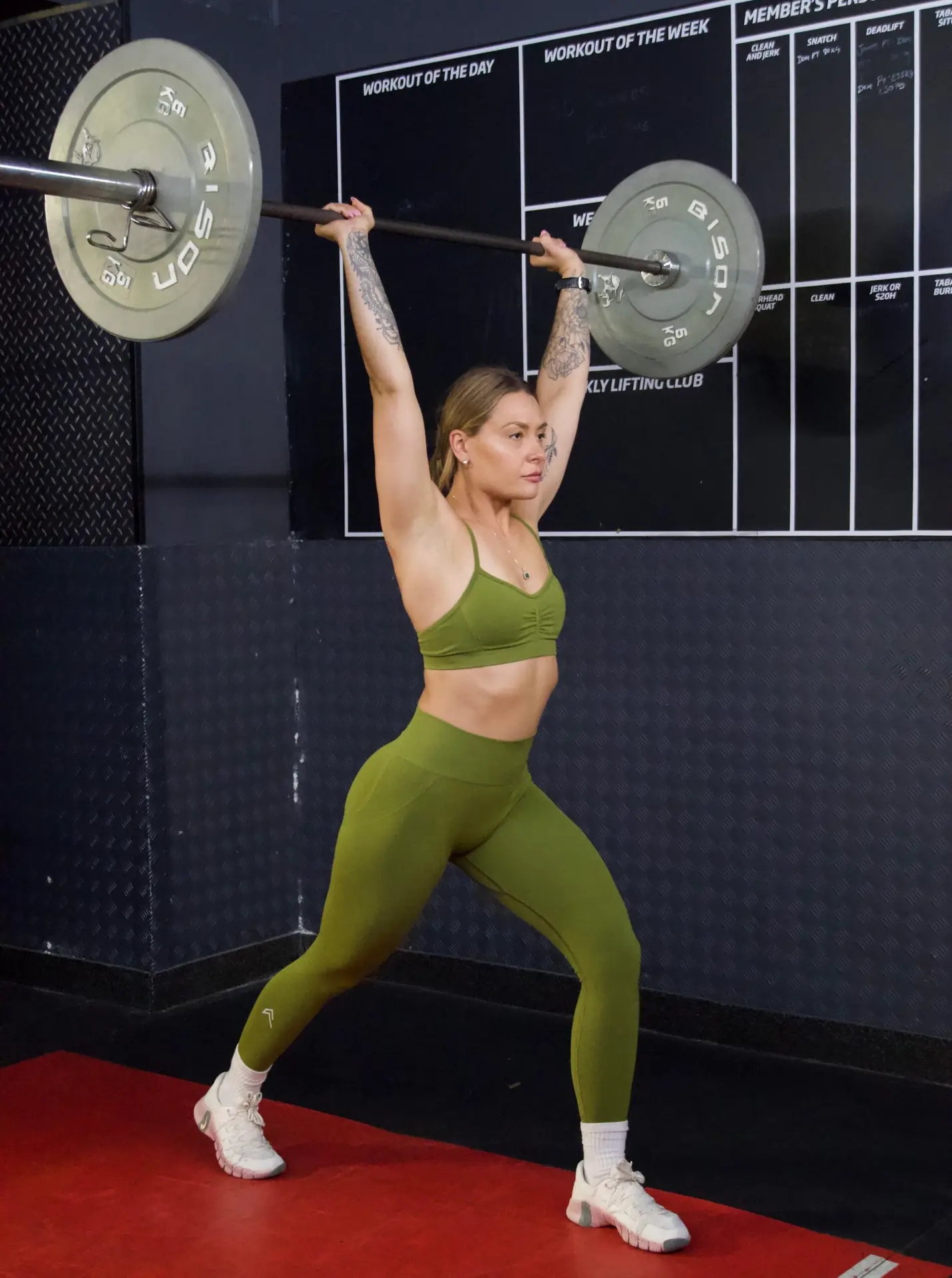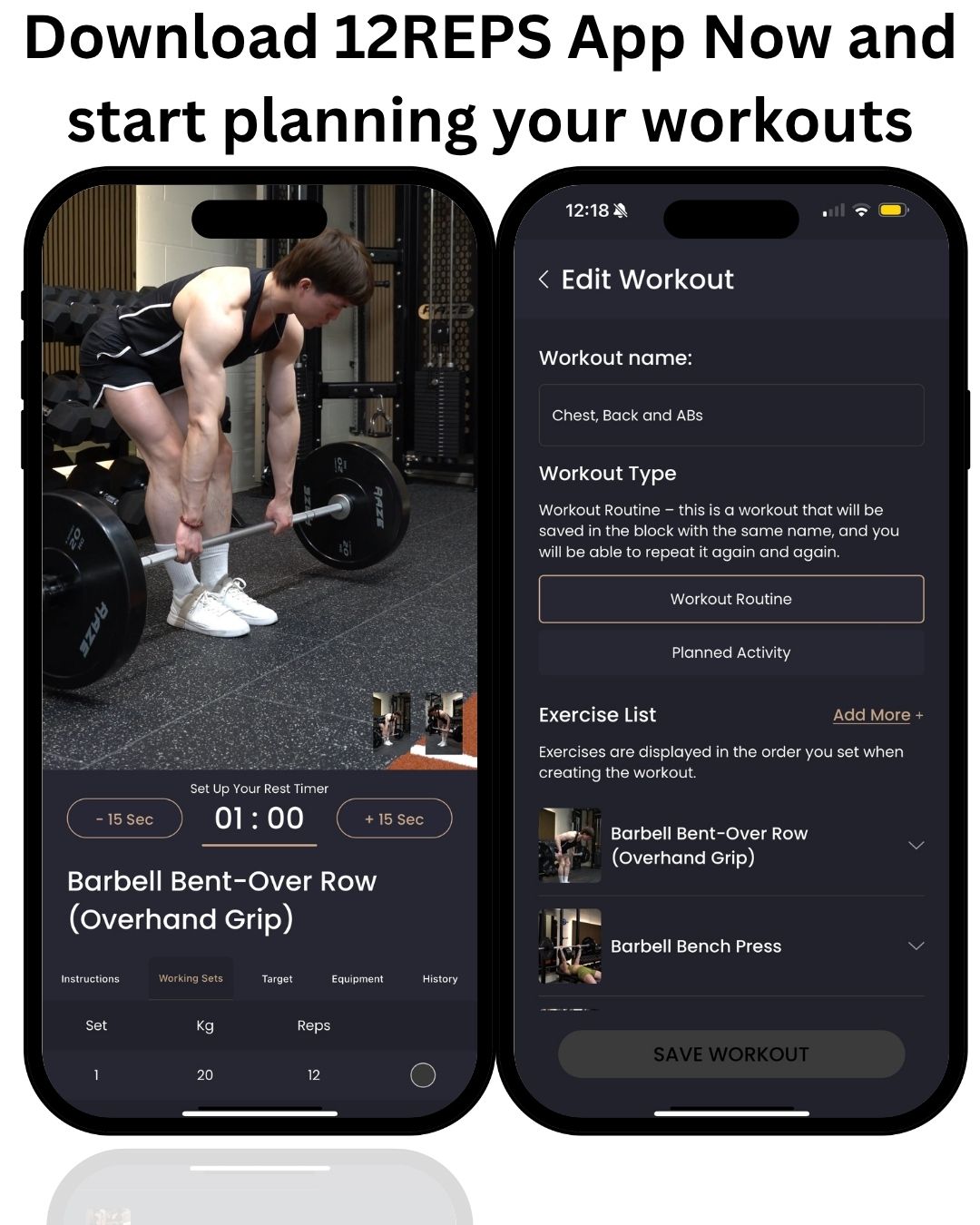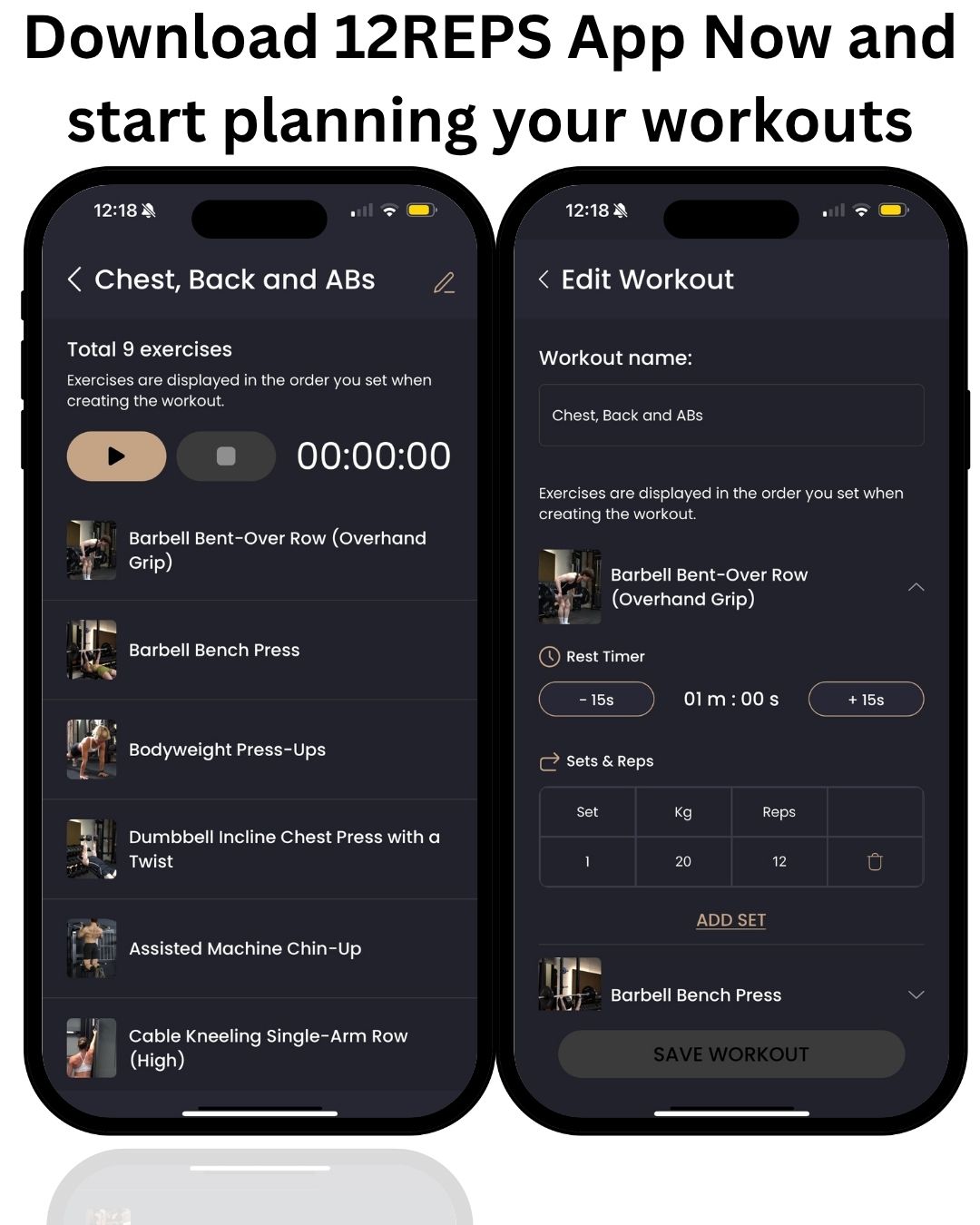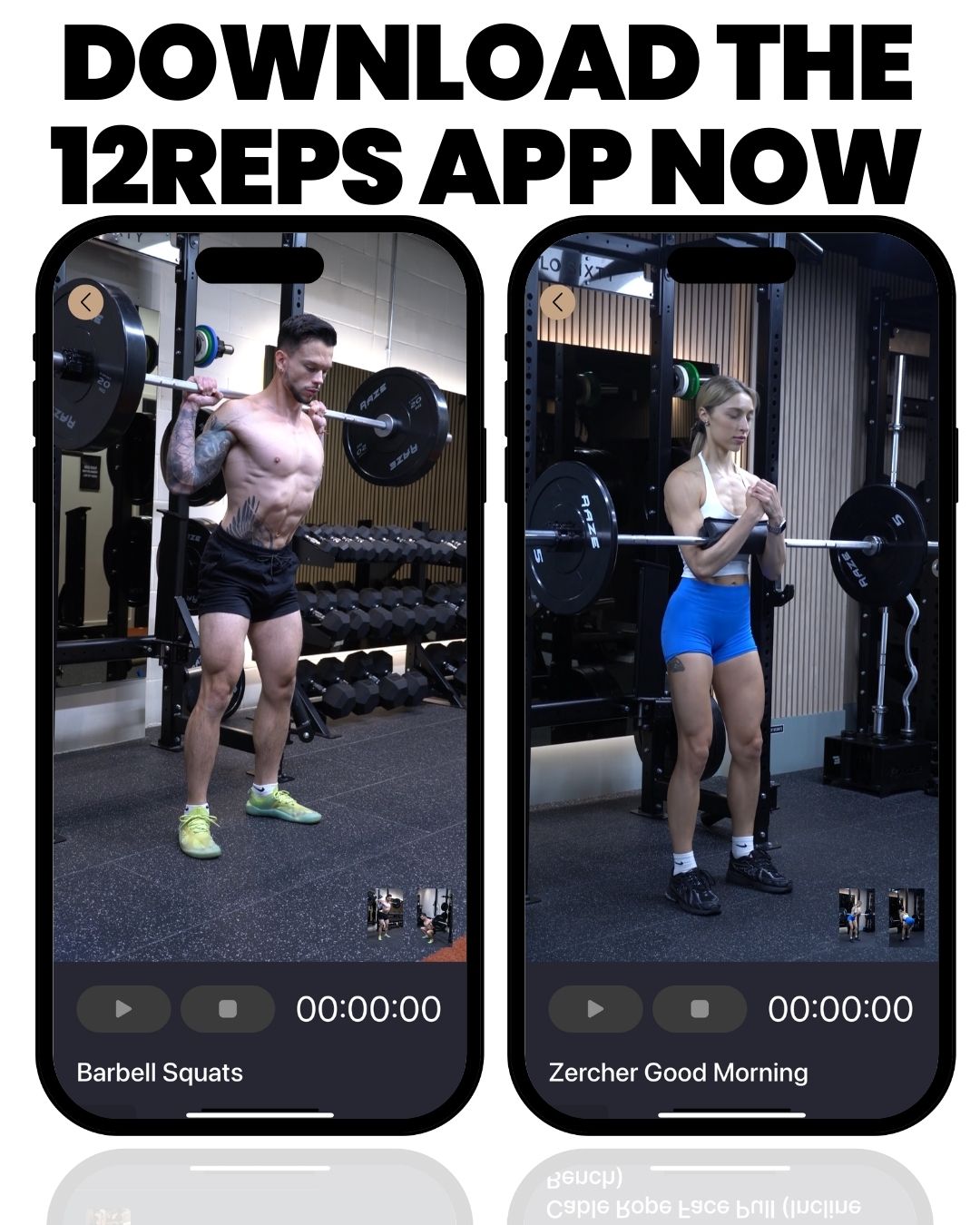By Will Duru, BSc (Hons) Sport and Exercise Science, Award-winning Personal Trainer with over 10 years of experience in strength training and optimising recovery.
I’m Will Duru, and if you’re reading this, you’re probably thinking about starting your strength training journey or maybe you’ve been going to the gym but feel like you’re not getting the results you want. Trust me, I’ve been there, and I’ve helped hundreds of people just like you over the past decade.
When I first started training people, I noticed something that really bothered me. People would show up to the gym, wander around from machine to machine, do some random exercises, and leave feeling frustrated because they weren’t seeing any real changes. It was like watching someone try to build a house without blueprints, they had all the tools but no plan.
That’s exactly why I created the 12Reps app and why I’m sharing this comprehensive 12-week program with you today. This isn’t just another workout tracker or generic fitness app. This comprehensive system is designed to help you build muscle, lose fat, and develop the kind of strength that will serve you for a lifetime.
The program you’re about to discover combines the proven effectiveness of push/pull/legs training with the convenience and intelligence of modern technology. Whether you’re a complete beginner who’s never touched a weight or someone who’s been training for a while but wants better results, this strength training program will meet you where you are and take you where you want to go.
What makes this different from every other free workout program you might find online? It’s built on real science, tested with real people, and designed to work with the equipment you actually have access to. Plus, with the 12Reps app, you’ll have a muscle-building app that adapts to your progress and keeps you motivated every step of the way.
Over the next 12 weeks, you’re not just going to get stronger and build muscle. You’re going to develop habits that will improve your quality of life, reduce your risk of injury, and potentially add years to your life. The research is clear, strength training isn’t just about looking good (though that’s a nice bonus). It’s about building a body that can handle whatever life throws at you.
So grab your water bottle, lace up your trainers, and let’s dive into the science behind why this program works and how you can use it to transform your life.

Understanding Push/Pull/Legs: The Perfect Training Split
Now that you understand why strength training is so important, let’s talk about why the push/pull/legs split is absolutely perfect for building muscle and strength, especially when you’re training four times per week.
The beauty of push/pull/legs lies in its simplicity and effectiveness. Instead of trying to train every muscle group in every workout (which leads to poor recovery and mediocre results), we group muscles based on their function and train them together. This approach allows each muscle group to recover properly while you train others, leading to better gains and a reduced risk of overtraining.
Let me break down each component for you:
Push Day focuses on all the muscles involved in pushing movements – your chest, shoulders, and triceps. When you do a push-up or bench press, all three of these muscle groups work together. By training them on the same day, we’re working with your body’s natural movement patterns rather than against them.
Pull Day targets the muscles involved in pulling movements – your back and biceps. Think about doing a pull-up or rowing motion. Your lats, rhomboids, rear delts, and biceps all work as a team to complete these movements. Training them together makes perfect sense from both a functional and recovery standpoint.
Legs Day covers everything from your hips down, quads, hamstrings, glutes, and calves. Your lower body contains some of the largest and strongest muscles in your body, so they deserve their own dedicated session.
Core Day is our fourth training day, focusing specifically on building a strong, stable midsection. Your core is involved in virtually every movement you make, both in the gym and in daily life. A strong core improves your performance in all other exercises while protecting your spine from injury.
The magic happens when you combine this split with the right frequency. Training four times per week gives you the perfect balance between stimulus and recovery. You’re hitting each muscle group with enough volume to promote growth while allowing adequate time for recovery and adaptation.
Research has consistently shown that training each muscle group 2-3 times per week is optimal for muscle growth and strength gains. With our push/pull/legs/core split, you’re hitting your upper body muscles twice per week (once on push day, once on pull day for some overlap), your legs once per week with high volume, and your core gets dedicated attention once per week, plus involvement in all other exercises.
This split also works incredibly well with the equipment you mentioned – dumbbells, TRX, kettlebells, machines, medicine balls, sledgehammers, and barbells. Each piece of equipment has its strengths, and we’ll use them strategically throughout the program to maximise your results.
The 12Reps app makes following this split effortless. Instead of having to remember which exercises to do on which days, the app guides you through each workout with video demonstrations, proper form cues, and automatic progress tracking. It’s like having a personal trainer in your pocket, ensuring you never waste time wondering what to do next.
What I love most about this approach is how it teaches you to think about movement patterns rather than just individual muscles. This carries over into real life, making you stronger and more capable in everything you do. Whether you’re lifting a heavy box, playing sports, or simply getting up from a chair, you’ll move more efficiently and feel more confident in your body.
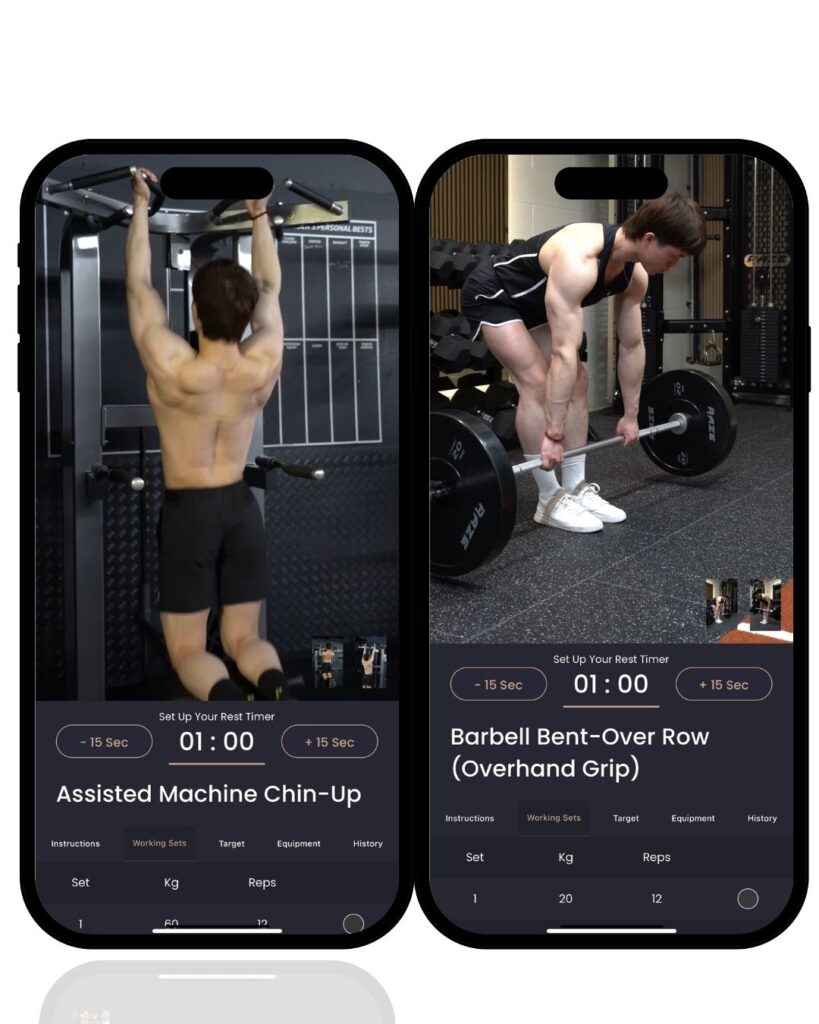
Getting Started: Essential Things to Consider When Joining the Gym
Starting your gym journey can feel overwhelming, especially if you’ve never set foot in a weight room before. I remember my first day at the gym, I was 16 years old, intimidated by all the equipment, and had no clue what I was doing. But here’s what I’ve learned after training hundreds of people: everyone starts somewhere, and the gym is actually one of the most supportive environments you’ll ever find.
The first thing you need to understand is that most people at the gym are focused on their own workouts. That person is benching twice their body weight? They’re not judging you for starting with just the bar. In fact, they probably respect you more for taking the first step. The fitness community is generally incredibly supportive of beginners who show up consistently and put in the effort.
When choosing a gym, look for a few key things. First, ensure they have the basic equipment you’ll need for this program – a good selection of dumbbells, barbells, machines, and some functional training equipment, such as TRX systems. The gym doesn’t need to be fancy, but it should be clean, well-maintained, and have enough equipment that you’re not constantly waiting around.
Location is crucial. The best gym is the one you’ll actually go to consistently. If it takes you 30 minutes to get there, you’re setting yourself up for failure. Find something within a 10-15 minute drive from your home or workplace. Convenience always trumps fancy amenities.
Consider the gym’s culture and peak hours. Visit at the times you plan to work out and see how busy it gets. Some gyms are packed at 6 PM but empty at 6 AM. Others have a more serious bodybuilding crowd, while some cater more to general fitness. Find one where you feel comfortable and motivated.
Don’t be afraid to ask for help. Most gyms offer a complimentary session with a trainer when you join. Even if you’re following this program, use that session to familiarise yourself with the equipment and get comfortable with the basic movements. A good trainer will respect that you have your own program and help you execute it safely.
Invest in proper gym attire. You don’t need expensive gear, but you do need clothes that allow you to move freely and shoes with good support. Avoid cotton shirts if you sweat a lot – moisture-wicking fabrics will keep you more comfortable. And please, for the love of all that’s holy, bring a towel and use it.
Start with a realistic schedule. If you’ve been sedentary for years, don’t commit to training six days a week. Our four-day program is perfect because it’s challenging enough to drive results but manageable enough to maintain over the long term. Consistency beats intensity every single time.
Set up your 12Reps app before your first workout. Having everything programmed and ready to go will eliminate decision fatigue and keep you focused on what matters – the actual training. The app will guide you through each exercise with video demonstrations, so you’ll never feel lost or confused about what to do next.

The Foundation: Proper Warm-Up and Cool-Down Protocols
One of the biggest mistakes I see people make is jumping straight into their workout without properly preparing their body. It’s like trying to drive your car at full speed when the engine is still cold, you might get away with it for a while, but eventually, something’s going to break.
A proper warm-up serves several crucial purposes. It gradually increases your heart rate and blood flow to your muscles, raises your core body temperature, and prepares your nervous system for the work ahead. It also increases the production of synovial fluid in your joints, which acts like oil in an engine, reducing friction and improving mobility.
Here’s the warm-up protocol I want you to follow before every workout:
Phase 1: General Warm-Up (5 minutes)
Start with 5 minutes of light cardio to get your blood flowing. This could be walking on a treadmill, easy cycling, or using an elliptical machine. The goal isn’t to exhaust yourself – you should be able to hold a conversation throughout. You’re just waking up your cardiovascular system and starting to raise your core temperature.
Phase 2: Dynamic Mobility (5-8 minutes)
This is where we start preparing your joints and muscles for the specific movements you’ll be doing. Dynamic stretching involves moving your joints through their full range of motion in a controlled manner. Here are the key movements to include:
- Arm circles (forward and backward)
- Leg swings (front to back and side to side)
- Hip circles
- Torso twists
- Walking lunges with a twist
- High knees and butt kicks
- Shoulder rolls and shrugs
The beauty of dynamic stretching is that it improves mobility while maintaining muscle activation. Unlike static stretching (holding a stretch for 30+ seconds), dynamic movements actually enhance your performance rather than potentially reducing it.
Phase 3: Activation and Movement Prep (3-5 minutes)
This final phase involves doing lighter versions of the movements you’ll be performing in your workout. If it’s push day, do some bodyweight push-ups and arm swings. If it’s leg day, do some bodyweight squats and glute bridges. This helps establish proper movement patterns and activates the specific muscles you’ll be training.
The 12Reps app includes warm-up routines specific to each workout, taking the guesswork out of this crucial component. You’ll never have to wonder what to do – just follow the guided warm-up and you’ll be properly prepared for your training session.
Now let’s talk about cooling down, which is just as important but often completely ignored. After an intense workout, your heart rate is elevated, your muscles are tight, and metabolic waste products have accumulated in your tissues. A proper cool-down helps your body transition back to its resting state safely and efficiently.
Cool-Down Protocol:
Phase 1: Gradual Heart Rate Reduction (3-5 minutes)
Don’t just stop exercising abruptly. Spend a few minutes doing light cardio – walking on a treadmill or easy cycling – to gradually bring your heart rate down. This helps prevent blood from pooling in your extremities and reduces the risk of dizziness or fainting.
Phase 2: Static Stretching (8-12 minutes)
Now is the time for static stretching. Hold each stretch for 30-60 seconds, focusing on the muscles you just trained. This helps improve flexibility, reduces muscle tension, and can help prevent soreness the next day. The key is to stretch while your muscles are still warm from the workout.
For push day, focus on chest, shoulder, and tricep stretches. For pull day, emphasise back and bicep stretches. For leg day, hit all the major lower body muscles – quads, hamstrings, glutes, and calves.
Phase 3: Recovery and Reflection (2-3 minutes)
Take a moment to log your workout in the 12Reps app, noting how you felt, any improvements in weight or reps, and any areas that need attention. This reflection time helps reinforce the positive habit you’re building and keeps you connected to your progress.
Proper warm-up and cool-down protocols might add 15-20 minutes to your gym session, but they’re absolutely worth it. They’ll help you perform better, recover faster, and stay injury-free throughout your 12-week journey and beyond.
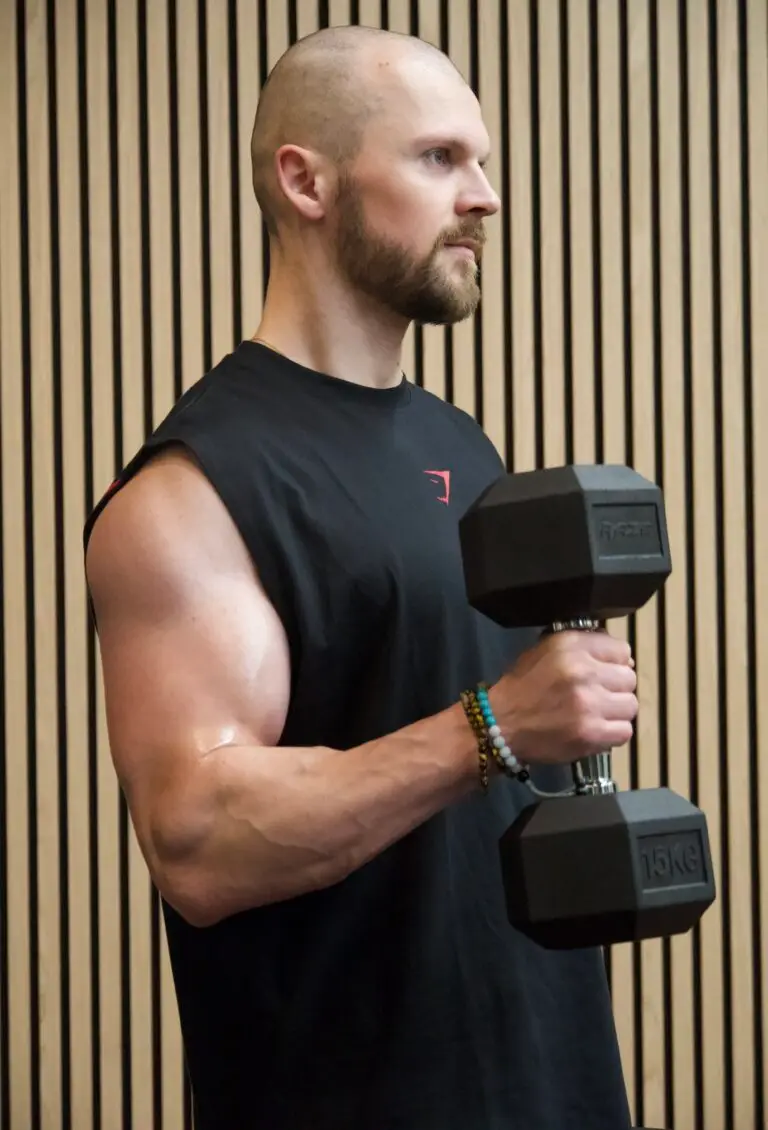
The 12-Week Program: Your Complete Workout Plan
Now we get to the exciting part, your actual workout program! This 12-week strength training program is designed to help you progress from your current level to a significantly stronger, more muscular, and more confident version of yourself. The program is divided into three distinct phases, each building on the previous one to ensure continuous progress and prevent plateaus.
The beauty of this program is its adaptability. Whether you’re a complete beginner or someone who’s been training for a while, the 12Reps app will help you adjust the weights and intensity to match your current fitness level. The app’s intelligent progress tracking system ensures you’re always working at the right intensity to drive results.
Weekly Schedule:
– Monday: Push Day (Chest, Shoulders, Triceps)
– Tuesday: Pull Day (Back, Biceps)
– Wednesday: Rest or Light Cardio
– Thursday: Legs Day (Quads, Hamstrings, Glutes, Calves)
– Friday: Core Day
– Saturday: Rest or Active Recovery
– Sunday: Rest
This four-day split gives you the perfect balance between training stimulus and recovery time. You’re hitting each major muscle group with adequate volume while allowing sufficient time for adaptation and growth.
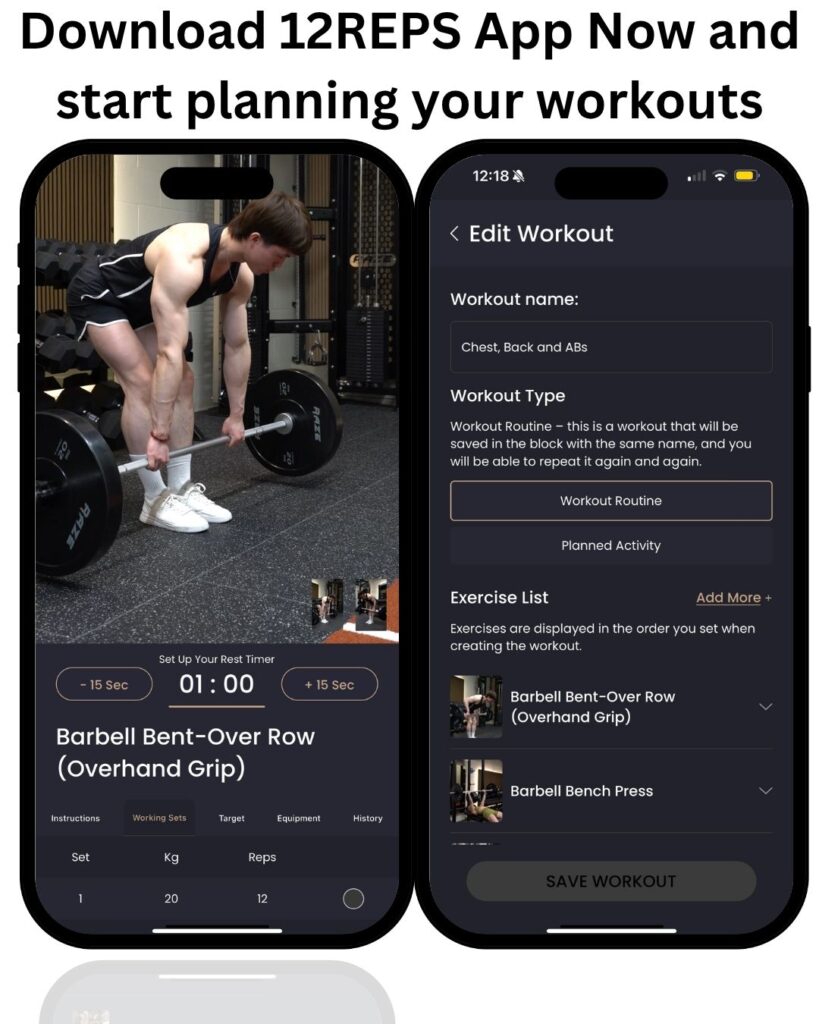
Push Day (Chest, Shoulders, Triceps)
Exercise | Sets | Reps | Weight | Rest Period | Equipment |
Dumbbell Bench Press | 4 | 10-12 | 60-70% 1RM | 90 seconds | Dumbbells |
Overhead Press (Standing) | 4 | 10-12 | 60-70% 1RM | 90 seconds | Dumbbells |
Incline Dumbbell Press | 4 | 10-12 | 60-70% 1RM | 90 seconds | Dumbbells |
Lateral Raises | 4 | 10-12 | Light-Moderate | 60 seconds | Dumbbells |
Tricep Dips | 4 | 10-12 | Bodyweight | 60 seconds | Bodyweight |
Overhead Tricep Extension | 4 | 10-12 | Moderate | 60 seconds | Dumbbells |
Key Focus Points for Push Day:
- Start with the dumbbell bench press to establish proper pressing mechanics
- Keep your core engaged throughout all pressing movements
- Focus on controlled movement – 2 seconds down, 1 second pause, 2 seconds up
– Use the 12Reps app to track your weights and ensure progressive overload
Pull Day (Back, Biceps)
Exercise | Sets | Reps | Weight | Rest Period | Equipment |
Bent-Over Dumbbell Rows | 4 | 10-12 | 60-70% 1RM | 90 seconds | Dumbbells |
Lat Pulldowns | 4 | 10-12 | 60-70% 1RM | 90 seconds | Machine |
Single-Arm Dumbbell Rows | 4 | 10-12 | 60-70% 1RM | 90 seconds | Dumbbells |
TRX Rows | 4 | 10-12 | Bodyweight | 60 seconds | TRX |
Dumbbell Bicep Curls | 4 | 10-12 | Moderate | 60 seconds | Dumbbells |
Hammer Curls | 4 | 10-12 | Moderate | 60 seconds | Dumbbells |
Key Focus Points for Pull Day:
- Initiate all pulling movements with your lats and middle traps, not your arms
- Keep your shoulder blades pulled back and down throughout
- Squeeze your back muscles at the top of each rep
– The 12Reps app will help you maintain proper form with video demonstrations
Legs Day (Quads, Hamstrings, Glutes, Calves)
Exercise | Sets | Reps | Weight | Rest Period | Equipment |
Goblet Squats | 4 | 10-12 | 60-70% 1RM | 90 seconds | Dumbbells |
Romanian Deadlifts | 4 | 10-12 | 60-70% 1RM | 90 seconds | Dumbbells |
Bulgarian Split Squats | 4 | 10-12 | Bodyweight | 90 seconds | Bodyweight |
Leg Press | 4 | 10-12 | 60-70% 1RM | 90 seconds | Machine |
Walking Lunges | 4 | 10-12 | Bodyweight | 60 seconds | Bodyweight |
Calf Raises | 4 | 10-12 | Bodyweight | 60 seconds | Bodyweight |
Key Focus Points for Legs Day:
- Master the hip hinge pattern with Romanian deadlifts
- Keep your knees tracking over your toes during squatting movements
- Focus on full range of motion in all exercises
– Use the 12Reps app to track your 1RM and ensure proper progression
Core Day
Exercise | Sets | Reps | Weight | Rest Period | Equipment |
Plank | 4 | 30-45 sec | Bodyweight | 60 seconds | Bodyweight |
Russian Twists | 4 | 10-12 | Medicine Ball | 60 seconds | Medicine Ball |
Dead Bug | 4 | 10-12 | Bodyweight | 60 seconds | Bodyweight |
Mountain Climbers | 4 | 10-12 | Bodyweight | 60 seconds | Bodyweight |
Bicycle Crunches | 4 | 10-12 | Bodyweight | 60 seconds | Bodyweight |
TRX Pike | 4 | 10-12 | Bodyweight | 60 seconds | TRX |
Key Focus Points for Core Day:
- Quality over quantity – perfect form is more important than speed
- Breathe normally during static holds like planks
- Focus on anti-extension and anti-rotation movements
– The 12Reps app includes detailed form cues for each core exercise
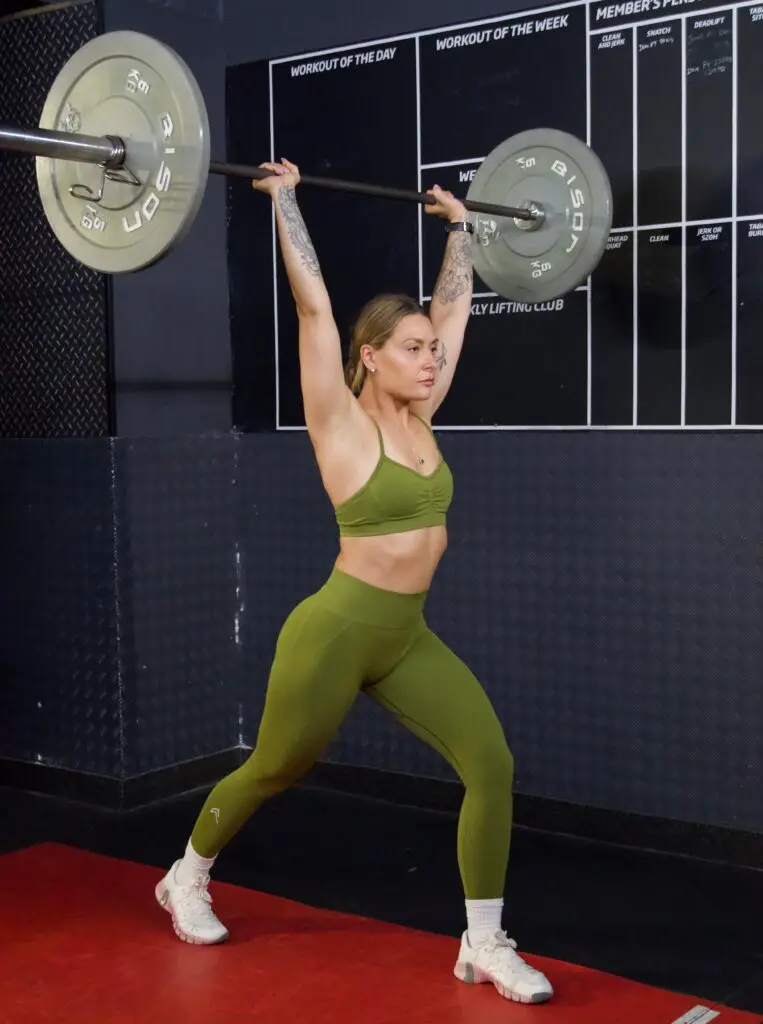
Phase 2: Strength Development (Weeks 5-8)
Welcome to phase two! By now, you should be comfortable with the basic movement patterns and ready to increase the intensity. This phase introduces supersets, performing two exercises back-to-back with minimal rest between them. This increases the training density and challenges your work capacity while continuing to build strength and muscle.
The weights also increase to 70-80% of your 1RM for the main compound movements. The 12Reps app will automatically calculate these percentages based on your performance in phase one, taking the guesswork out of progression.
Push Day (Chest, Shoulders, Triceps)
Exercise | Sets | Reps | Weight | Rest Period | Equipment | |
Barbell Bench Press | 4 | 10-12 | 70-80% 1RM | 2 minutes | Barbell | – |
Incline Dumbbell Press | 4 | 10-12 | 70-80% 1RM | 90 seconds | Dumbbells | A1 |
Dumbbell Flyes | 4 | 10-12 | Moderate | 90 seconds | Dumbbells | A2 |
Military Press | 4 | 10-12 | 70-80% 1RM | 90 seconds | Barbell | B1 |
Lateral Raises | 4 | 10-12 | Moderate | 90 seconds | Dumbbells | B2 |
Close-Grip Push-ups | 4 | 10-12 | Bodyweight | 60 seconds | Bodyweight | – |
Superset Instructions:
- Superset A: Perform incline dumbbell press immediately followed by dumbbell flyes, then rest 90 seconds
- Superset B: Perform military press immediately followed by lateral raises, then rest 90 seconds
Pull Day (Back, Biceps)
Exercise | Sets | Reps | Weight | Rest Period | Equipment | Superset |
Deadlifts | 4 | 10-12 | 70-80% 1RM | 2 minutes | Barbell | – |
Pull-ups/Assisted Pull-ups | 4 | 10-12 | Bodyweight | 90 seconds | Bodyweight | A1 |
Seated Cable Rows | 4 | 10-12 | 70-80% 1RM | 90 seconds | Machine | A2 |
T-Bar Rows | 4 | 10-12 | 70-80% 1RM | 90 seconds | Barbell | B1 |
Barbell Curls | 4 | 10-12 | Moderate | 90 seconds | Barbell | B2 |
TRX Face Pulls | 4 | 10-12 | Bodyweight | 60 seconds | TRX | – |
Legs Day (Quads, Hamstrings, Glutes, Calves)
Exercise | Sets | Reps | Weight | Rest Period | Equipment | Superset |
Barbell Back Squats | 4 | 10-12 | 70-80% 1RM | 2 minutes | Barbell | – |
Romanian Deadlifts | 4 | 10-12 | 70-80% 1RM | 90 seconds | Barbell | A1 |
Leg Curls | 4 | 10-12 | 70-80% 1RM | 90 seconds | Machine | A2 |
Leg Press | 4 | 10-12 | 70-80% 1RM | 90 seconds | Machine | B1 |
Leg Extensions | 4 | 10-12 | 70-80% 1RM | 90 seconds | Machine | B2 |
Kettlebell Swings | 4 | 10-12 | Moderate | 60 seconds | Kettlebell | – |
Core Day
Exercise | Sets | Reps | Weight | Rest Period | Equipment | Superset |
Weighted Plank | 4 | 30-45 sec | Light Weight | 60 seconds | Weight Plate | A1 |
Medicine Ball Slams | 4 | 10-12 | Heavy | 60 seconds | Medicine Ball | A2 |
Hanging Leg Raises | 4 | 10-12 | Bodyweight | 90 seconds | Pull-up Bar | B1 |
Russian Twists | 4 | 10-12 | Medicine Ball | 90 seconds | Medicine Ball | B2 |
TRX Mountain Climbers | 4 | 10-12 | Bodyweight | 60 seconds | TRX | – |
Sledgehammer Swings | 4 | 10-12 | Heavy | 60 seconds | Sledgehammer | – |
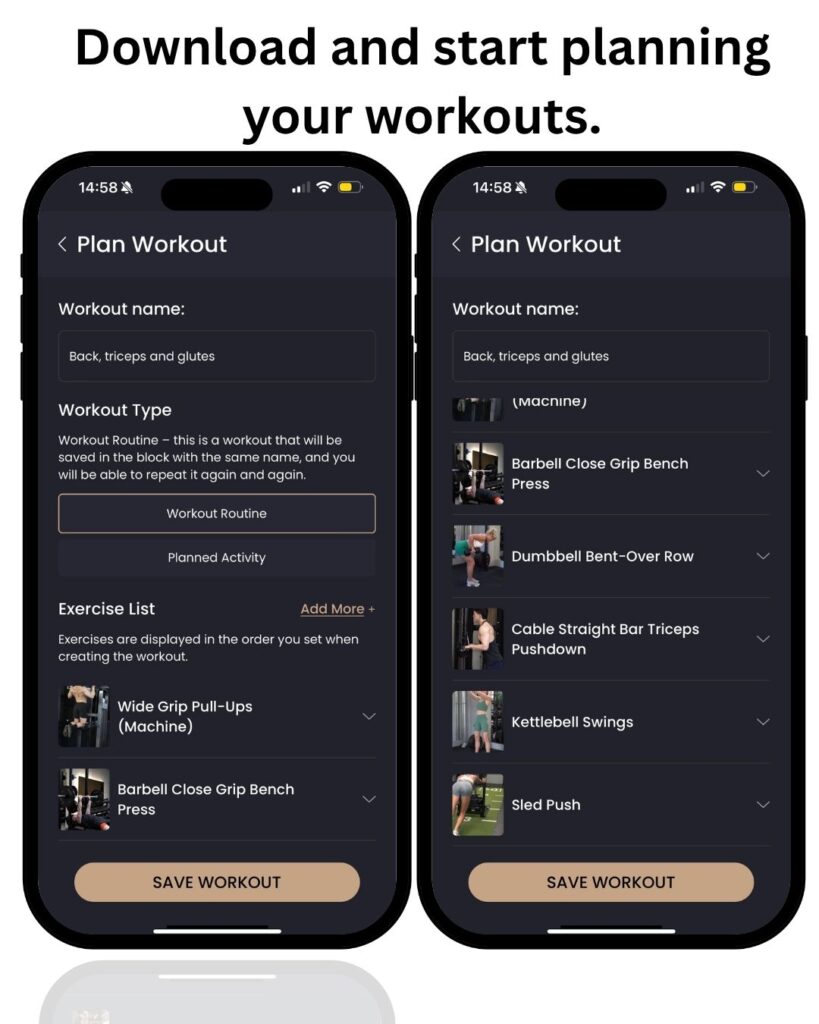
Maximising Your Results with the 12Reps App
The 12Reps app is more than just a workout tracker – it’s your complete training companion designed to maximise your results while minimising the guesswork. Here’s how to get the most out of this powerful muscle-building app:
Exercise Demonstrations: Every exercise in your program is accompanied by high-quality video demonstrations. Don’t just watch these once – reference them regularly, especially when learning new movements or when fatigue starts to affect your form. The app allows you to slow down videos and replay specific sections to really understand the movement mechanics.
Progressive Overload Tracking: The app automatically tracks your 1RM max and suggests appropriate weight increases based on your performance. This eliminates the guesswork from progression, ensuring you’re always working at the optimal intensity to drive results.
Volume Tracking: The app calculates your total volume lifted for each workout and over time. This metric is crucial for understanding your training load and ensuring you’re providing adequate stimulus for muscle growth.
Form Reminders: The app includes specific form cues and common mistakes to avoid for each exercise. Use these reminders to maintain perfect technique even when you’re tired or distracted.
Rest Timer: The built-in rest timer ensures you’re taking appropriate rest periods between sets. This might seem minor, but proper rest periods are crucial for maintaining performance throughout your workout.
Workout Notes: Use the notes feature to record how you felt during each workout, any form cues that worked well for you, or areas you want to focus on next time. This creates a personalised training log that becomes more valuable over time.
The key to success with any fitness app is consistency in using it. Make logging your workouts a non-negotiable part of your training routine. The data you collect will become incredibly valuable for understanding your progress and making informed decisions about your training.
Remember, the 12Reps app is designed to be your best workout app companion throughout this journey and beyond. It grows with you, adapting to your progress and helping you continue improving long after these initial 12 weeks are complete.
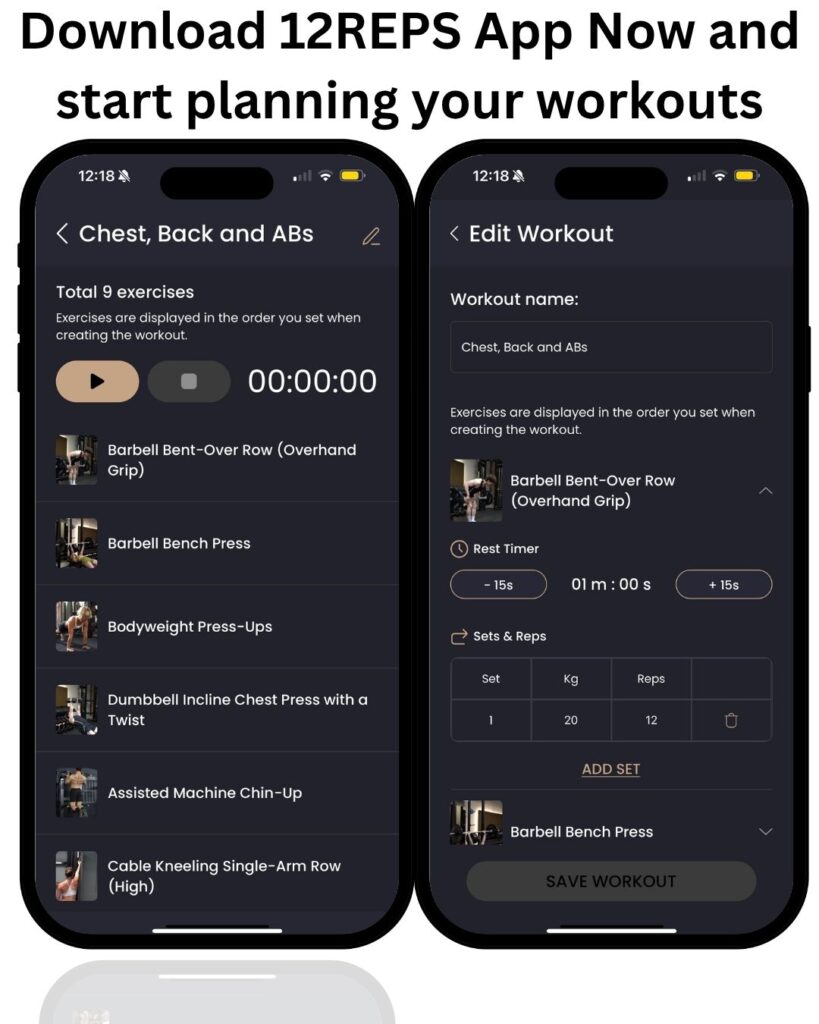
Conclusion: Your Journey to a Stronger, Healthier You
Congratulations! You now have everything you need to embark on a transformative 12-week journey that will not only change how you look and feel but potentially add years to your life and life to your years.
This isn’t just another free workout program, it’s a comprehensive system designed to help you build muscle and lose fat while developing the kind of functional strength that will serve you for decades to come. The combination of proven training principles, progressive programming, and the intelligent features of the 12Reps app gives you every tool you need to succeed.
Remember what we’ve learned from the research: strength training isn’t just about building muscle or looking good in the mirror. It’s about maintaining your independence as you age, reducing your risk of injury, improving your bone density, boosting your metabolism, and potentially extending your lifespan. Every rep you complete is an investment in your future self.
The 12Reps app will be your constant companion throughout this journey, providing expert guidance, tracking your progress, and celebrating your achievements. Whether you’re using it as a bodyweight training app for home workouts or as a comprehensive strength training app for gym sessions, it adapts to your needs and grows with your progress.
As you begin this program, remember that consistency always trumps perfection. You don’t need to be perfect, you just need to show up and do the work. Some days will be amazing, others will be challenging, but every single workout matters. The compound effect of consistent training will surprise you with its power.
Don’t be discouraged if progress seems slow at first. Building real, lasting strength and muscle takes time, but the changes will come if you stick with the program. Use the progress tracking features in the 12Reps app to see how far you’ve come, even when day-to-day changes may not be immediately obvious.
Most importantly, enjoy the process. There’s something incredibly empowering about getting stronger week after week, mastering new movements, and pushing past limitations you thought were permanent. The confidence you build in the gym will carry over into every other area of your life.
Your journey to a stronger, healthier, more confident you starts with your very next workout. Download the 12Reps app, review your Phase 1 program, and take that first step. Your future self will thank you for taking the first step today.
Remember, this is just the beginning. The habits, knowledge, and strength you build over the next 12 weeks will serve as the foundation for a lifetime of health and vitality. The 12Reps app will continue to support your journey long after this initial program is complete, helping you set new goals and reach new heights.
Welcome to the beginning of the strongest, healthiest chapter of your life. Let’s get started!
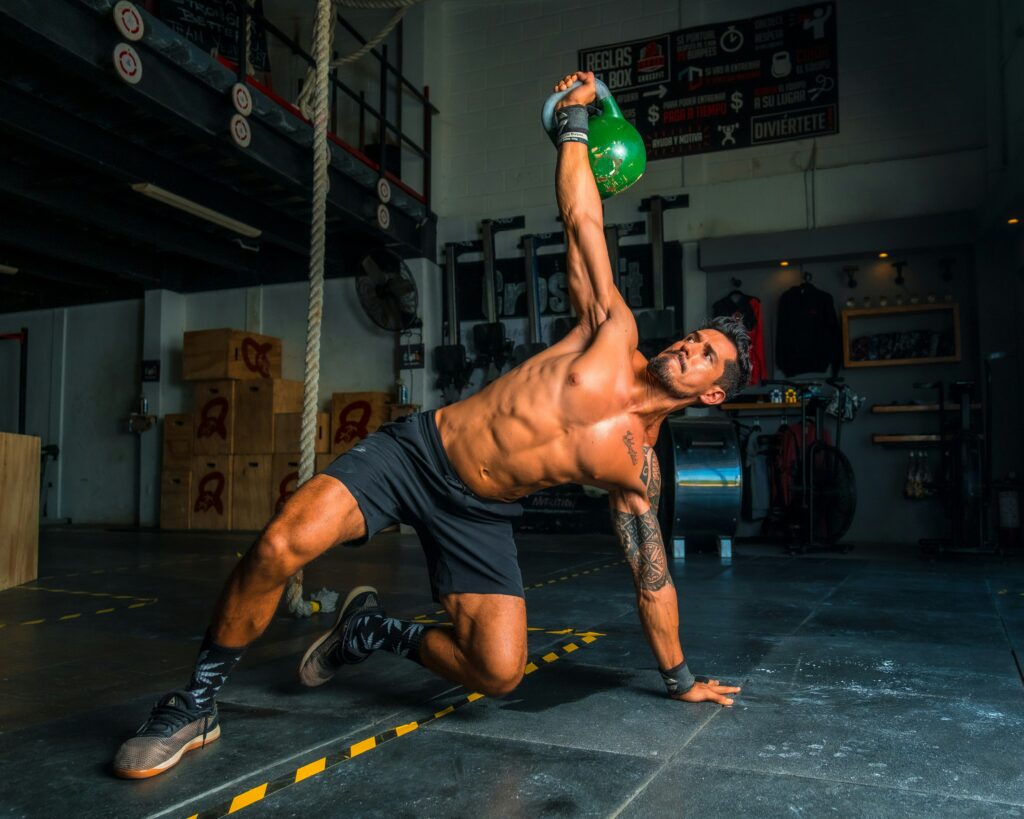
References
[1] Harvard Health Publishing. (2021). Want to live longer and better? Do strength training. Harvard Medical School. https://www.health.harvard.edu/staying-healthy/want-to-live-longer-and-better-do-strength-training
[2] NPR Health Shots. (2024). Women who do strength training live longer. How much is enough? National Public Radio. https://www.npr.org/sections/health-shots/2024/03/11/1236791784/strength-resistance-weight-training-longevity-aging-heart-disease
[3] 12Reps. (2025). Why the 12Reps App Will Elevate Your Strength Training Program. https://just12reps.com/why-the-12reps-app-will-elevate-your-strength-training-program/
__________________________________________________
About the Author: Will Duru holds a BSc (Hons) in Sport and Exercise Science and is an award-winning personal trainer with over 10 years of experience in strength training and optimizing recovery. He is the founder of the 12Reps app and has been featured in Men’s Health, Men’s Fitness, Women’s Fitness, Women’s Health, Telegraph, The Sun, and Coachweb. Will is passionate about making effective strength training accessible to everyone, regardless of their experience level or available equipment.

